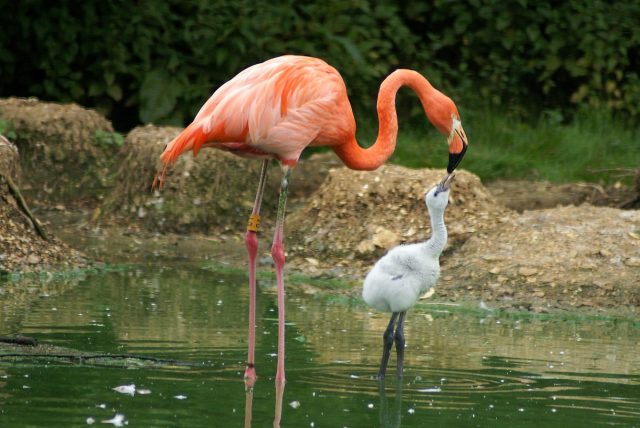During my younger days, I had no particular attraction to flamingoes. They’re not common in the wilds of North Dakota, and pink has never been my favorite color. But a few years back, my husband and I were having a conversation about our spirit animals. He offered a convincing argument that the flamingo was mine. “They sleep standing up,” he explained.
I’ve felt a special kinship with flamingoes ever since, and they’re a recurring theme on this blog.
Flamingoes’ standing abilities have also fascinated scientists, although this fascination seems to be fueled more by curiosity than envy. How can these animals balance their big bird bodies on their long spindly legs? How can they do this even when sleeping?
In 2017, two intrepid biomechanics from Georgia (the state, not the country) enlisted the help of the Birmingham Zoo in Alabama, to decode some of the flamingo’s standing secrets.
Where a Flamingo Hides its Knees
First, consider the bird leg (and I don’t mean chicken thighs). If you’ve spent much time watching flamingoes, or even watching robins hopping around in your yard, you may have noticed that birds have odd slant to their legs. Why is it, you may have wondered, that bird knees bend backwards?
The half-intriguing, half-annoying answer is: they don’t. Birds have knees that bend the same direction as ours. But bird legs are built from a different pattern, and our untrained eyes mistake the details.
Bird femurs are short, nearly horizontal, and tucked close to their bodies. Their knees are also pulled tight to the torso. Since the upper parts of bird legs are obscured by feathers, we may confuse the knee joint with the hip. Birds’ ankles are found about halfway up their legs, and it’s these joints that bend backwards, and which we perceive as knees. When birds walk, they tiptoe.

Photo taken from the supplementary materials for “Mechanical evidence that flamingos can support their body on one leg with little active muscular force.”
Lessons from Dead Flamingoes
The scientists used both living and dead flamingoes for their experiments. The dead flamingoes (which were euthanized by the zoo for other, non-disclosed reasons) were propped up at the ankles using bone clamps. The scientists, using scientific methods such as poking the dead birds with a stick, figured out what would knock the flamingoes off-balance.
These experiments were surprisingly enlightening. They found that if a leg was angled inward so that it was centered under the body (mimicking a flamingo standing on one leg), then the hip and knee joints would remain stable, even if the whole flamingo was tilted back and forth. The bird’s own bodyweight helped press the joints into this locked position.
Stability was lost when the leg was completely vertical (mimicking a two-legged stance). In this case, the hip and knee joints weren’t locked, and the body flopped around like…well, like a dead flamingo.
How Living Flamingoes Find Balance
The experiments with live flamingoes were significantly cuter. Fluffy juvenile flamingoes were induced to stand on a force plate, which measured pressure changes. The scientists then calculated the changes in pressure when the birds were active, still, or quiescent (either asleep, or heading that direction).
The quiescent birds were remarkably stable. The center of pressure stayed within a small radius, and changes were neither fast nor wide. The alert birds (who were grooming, shaking, and otherwise moving around) had a center or pressure radius twice as large as the quiescent birds, and the changes were faster and broader.
All this evidence together suggests that flamingoes can balance on one leg with virtually no effort. (Though the scientists noted they didn’t measure muscle activity directly, and therefore couldn’t say with certainty how much energy was required.)
More Reasons for Envy
Considering my tree pose is about as stable as a toddler’s block tower, I envy flamingoes their ability to fall asleep on one leg. (Back when my sciatica was at its worst, I made plans to Velcro myself to a vertical mattress. This could have been a good story, but my sewing and mechanical skills did not allow it to happen.)
Though I have done no research into the matter, and it’s outside the scope of this paper, I assume that flamingoes aren’t prone to vein problems and swelling in their feet. I don’t remember seeing a flamingo with edema in its feet. But then, swollen flamingo legs would probably still look spindly.
I still claim the flamingo as my spirit animal, although I now realize this is based on admiration and wishful thinking rather than actual parallels.
Oh yeah. Flamingoes can also fly. That’s also neat.
